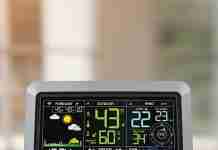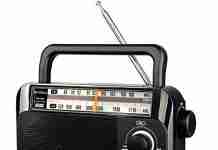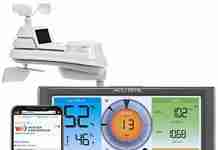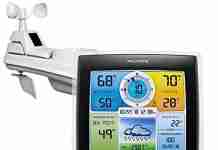Living in an area prone to high winds can be challenging, especially when it comes to protecting our beloved home weather station sensors. While we rely on these sensors to provide accurate and up-to-date weather information, it’s crucial to take the necessary precautions to ensure their security. In this article, we will explore some practical tips and techniques to safeguard our home weather station sensors during those gusty, blustery days. So, let’s dive into the world of weather station security and keep our sensors safe and sound!
Review contents
Choosing a Secure Location
When it comes to ensuring the security of our home weather station sensors in high winds, one of the first considerations is choosing a secure location. By selecting a suitable site, we can greatly reduce the risk of damage or displacement during extreme weather conditions.
Avoiding Exposed Areas
To protect our weather station sensors from the full force of high winds, it is crucial to avoid placing them in exposed areas. Exposed areas, such as hilltops or open fields, are more prone to strong gusts and can subject our sensors to unnecessary stress. Instead, we should aim to position our sensors in areas that are naturally sheltered, such as near buildings or trees, which can help to deflect the wind.
Considering Obstructions
Another important factor in choosing a secure location is considering potential obstructions. By placing our weather station sensors behind obstructions like fences, walls, or other structures, we can provide them with an added layer of protection. These obstructions act as barriers, blocking or diverting the wind, and reducing the impact on our sensors.
Evaluating Wind Patterns
Lastly, we should take the time to evaluate wind patterns in our specific location. By understanding the prevailing wind directions and intensities, we can strategically position our weather station sensors to minimize vulnerability. For example, if we know that the wind typically comes from a certain direction, we can position our sensors in a way that reduces their exposure to that particular wind direction.
Fixing the Sensors Properly
Once we have selected a secure location for our home weather station sensors, it is essential to ensure they are properly fixed in place. This will help prevent any movement or displacement during high winds, which could lead to inaccurate data or potential damage.
Checking Mounting Options
Before fixing our sensors, we should carefully consider the available mounting options. Various weather stations come with different mounting methods, such as pole mount, wall mount, or roof mount. It is crucial to choose a mounting option that is appropriate for our specific sensors and the chosen location. We should ensure that the chosen mount is sturdy and can withstand the expected wind conditions.
Securing the Sensor Housing
The housing of our weather station sensors plays a vital role in protecting the sensitive components from the elements. We should ensure that the housing is securely closed and sealed to prevent any water or dust ingress. Additionally, if the sensor housing is detachable, we should double-check that it is firmly attached to its base or mounting structure to minimize the risk of it being dislodged by strong winds.
Protecting Cables and Wiring
The cables and wiring connecting our weather station sensors are equally important to secure. We should carefully route and fasten the cables, ensuring they are not left exposed or at risk of being damaged during any wind-induced movement. Using cable clips or conduits can help keep the cables in place and protect them from potential snags or tugs.
Using Durable Materials
In order to enhance the overall longevity and resilience of our home weather station sensors, it is recommended to choose sensors constructed with durable materials and to utilize heavy-duty mounting hardware and weather-resistant cables.
Rugged Sensor Construction
Opting for weather station sensors made with rugged and robust materials can significantly increase their ability to withstand high winds. Sensors with sturdy housings, reinforced frames, and impact-resistant materials are more likely to endure the forces exerted by strong gusts without sustaining damage or compromising accuracy.
Heavy-Duty Mounting Hardware
Choosing heavy-duty mounting hardware, such as stainless steel brackets or galvanized poles, ensures that our sensors remain securely fixed in place during high winds. These robust materials are less prone to corrosion and can withstand the sustained forces that strong winds may exert on our sensors.
Weather-Resistant Cables
Using weather-resistant cables is vital to maintain the integrity of our weather station’s electrical connections. These cables are designed to withstand exposure to various weather conditions, including high winds, ensuring reliable data transmission. Additionally, the use of weather-resistant connectors and sealants can further enhance the protection of the cables from moisture, dust, and other elements.
Regular Maintenance
To keep our home weather station sensors secure in high winds, regular maintenance is key. By periodically inspecting, tightening, and cleaning the sensors, we can identify and address any potential issues before they escalate.
Inspecting Sensor Mounts
Regularly inspecting our sensor mounts is essential to confirm their stability and to identify any signs of wear or damage. Loose or weakened mounts can compromise the security of our sensors, making them more susceptible to movement during high winds. By tightening or replacing any damaged mounts promptly, we can ensure our sensors stay securely in place.
Tightening Connections
Checking and tightening the connections of our weather station sensors is crucial for maintaining accurate data collection. Over time, vibrations and environmental factors may cause the connections to loosen, potentially leading to erratic measurements. By regularly inspecting and tightening these connections, we can prevent any disruptions caused by loose wires or connectors.
Cleaning the Sensor
Regular cleaning of our weather station sensors is not only important for accurate weather data but also for maintaining their durability. Dust, dirt, or debris can accumulate on the sensor surfaces and compromise their performance. By using a soft, dry cloth or brush, we can remove any build-up and ensure the sensors remain clear and unobstructed, reducing the risk of inaccuracies caused by debris.
Wind Protection Accessories
In addition to the measures we have discussed so far, there are several wind protection accessories available that can provide an extra layer of security for our home weather station sensors.
Windbreaks or Wind Fences
Installing windbreaks or wind fences around our weather station sensors can help to reduce the wind speed and direct gusts away from the sensors. These structures can be made of various materials, such as wooden slats or perforated metal, and should be positioned strategically to achieve the desired wind reduction effect. Windbreaks can be particularly effective in shielding sensors located in open areas or exposed positions.
Guy Wires or Stakes
Using guy wires or stakes can provide additional stability to our weather station sensors, especially for taller poles or freestanding structures. Guy wires are attached to the sensor mount and anchored securely into the ground, creating tension that counteracts the force of the wind. Stakes are driven into the ground at multiple points, adding stability and preventing movement. These methods can significantly improve the resistance of our sensors to wind-induced vibrations or swaying.
Wind Speed Blocks
For areas prone to strong winds, wind speed blocks can help mitigate the impact on our weather station sensors. These blocks are designed to redirect or disrupt the flow of wind, reducing its speed and preventing it from directly hitting the sensors. Wind speed blocks can be customized or purchased as pre-fabricated structures, depending on the specific requirements of our location.
Utilizing Professional Installation
For those who may not have the necessary expertise or time to ensure the proper installation and security of their home weather station sensors, engaging weather station experts can provide peace of mind and professional guidance.
Engaging Weather Station Experts
Weather station experts have the knowledge and experience to assess our site, recommend the most suitable sensor placement, and provide expert installation services. These professionals can identify potential challenges specific to our location and suggest appropriate measures to optimize the security of our sensors in high winds. By working with experts, we can ensure that our weather station is installed correctly and efficiently, maximizing its longevity and accuracy.
Following Manufacturer Guidelines
Regardless of whether we choose to install our weather station sensors ourselves or enlist the help of professionals, it is crucial to follow the manufacturer’s guidelines. Manufacturers often provide specific instructions on the proper installation and maintenance of their weather station products. By adhering to these guidelines, we can minimize the risk of any installation errors and ensure the maximum security and performance of our sensors in high winds.
Monitoring and Alert Systems
To stay informed about the status of our weather station sensors during high winds, we can utilize monitoring and alert systems. These systems provide real-time wind data, notifications, and backup power options to help us proactively manage any potential risks.
Real-Time Wind Data
Monitoring systems equipped with real-time wind data allow us to stay aware of changing wind conditions at our location. By continuously observing the wind speed and direction, we can identify when conditions become hazardous for our sensors. Real-time wind data enables us to make informed decisions regarding sensor security and take appropriate measures to mitigate any risks.
Alert Notifications
Alert systems can be set up to notify us of any extreme weather conditions, including high winds, as detected by our weather station sensors. These notifications can be sent via various means, such as email or mobile app notifications, ensuring that we are promptly informed of any potential issues. Alert systems provide us with an extra layer of security by allowing us to take immediate action to safeguard our sensors when necessary.
Backup Batteries
Having backup batteries for our weather station sensors is crucial during high winds or power outages. These batteries ensure that our sensors continue to function and record data even when mains power is lost. By investing in reliable backup batteries, we can ensure uninterrupted operation and data collection during inclement weather conditions.
Emergency Preparedness
In addition to taking preventive measures, it is important to be prepared for any unexpected situations when it comes to our home weather station sensors in high winds. By having spare sensors, emergency repair tools, and suitable insurance coverage in place, we can minimize downtime and mitigate any potential damage or losses.
Storing Spare Sensors
Keeping spare sensors on hand allows for quick replacement in the event of sensor damage or failure during high winds. Spare sensors can be temporarily installed while repairs are being made to the primary set, ensuring continuous collection of weather data. It is essential to store spare sensors in a safe and secure location, protecting them from factors that may compromise their functionality.
Having Emergency Repair Tools
Preparing a kit with essential emergency repair tools can make a significant difference in addressing any sensor damage caused by high winds. This kit could include items such as extra mounting hardware, replacement connectors, and weather-resistant sealants. By having these tools readily available, we can minimize any delays in restoring the security and functionality of our sensors.
Obtaining Insurance Coverage
Weather station sensors can be valuable assets, and it is prudent to obtain suitable insurance coverage to protect against losses caused by high winds or other unforeseen events. Insurance coverage can include coverage for sensor damage or loss, as well as any related equipment or property damage. By having insurance coverage, we can have peace of mind knowing that we are financially protected in the event of any unpredictable situations.
Observing Local Weather Guidelines
To ensure the security of our home weather station sensors in high winds, it is crucial to observe local weather guidelines and regulations. Local building codes and weather advisory notices can provide valuable insights and recommendations to enhance the overall safety of our sensors.
Checking Local Building Codes
Local building codes often include guidelines for the installation of structures, which may apply to our weather station sensor setup. By checking these codes, we can ensure that our installation adheres to the necessary safety standards. Building codes may outline requirements for wind load resistance or prescribe specific mounting methods that are deemed safe for a given location. Adhering to these codes ensures that our sensors are installed securely and in compliance with local regulations.
Following Weather Advisory Notices
Weather advisory notices, issued by local weather authorities, provide valuable information on approaching severe weather conditions, including high winds. These notices may include specific precautions or recommendations for individuals with weather stations or similar equipment. By actively following these notices, we can proactively prepare for inclement weather and take appropriate measures to secure our sensors well in advance.
Learning from Case Studies
Lastly, we can learn valuable lessons from case studies that analyze failures and successes in securing home weather station sensors during high winds. By reviewing such studies and implementing the lessons learned, we can improve our own sensor security practices and reduce the risk of damage or loss.
Analyzing Failures in High Winds
Analyzing case studies that examine failures of weather station sensor security in high winds can help identify common vulnerabilities and pitfalls. By understanding the causes of failures, such as insecure mounting or inadequate protection, we can make informed decisions when securing our own sensors. Learning from the mistakes of others can save us from experiencing similar setbacks and ensure the longevity and reliability of our weather station equipment.
Implementing Lessons Learned
Case studies also provide valuable insights into successful strategies and practices for securing weather station sensors in high winds. By examining these success stories, we can adopt proven methods and adapt them to our specific circumstances. From innovative wind-blocking designs to reinforced mounting techniques, implementing these lessons learned can significantly enhance the security and performance of our sensors during extreme weather conditions.
In conclusion, ensuring the security of our home weather station sensors in high winds requires careful consideration, proper installation, regular maintenance, and adherence to local guidelines. By choosing a secure location, fixing the sensors properly, using durable materials, and utilizing wind protection accessories, we can minimize the risks associated with strong gusts. Regular maintenance, monitoring systems, and emergency preparedness measures further enhance the security and functionality of our sensors. By observing local weather guidelines and learning from case studies, we can continuously improve the security of our home weather station sensors in high winds and make informed decisions to protect our investment.



































